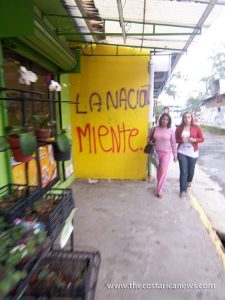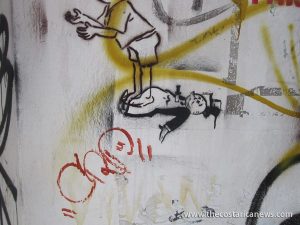San Jose is not known for the striking murals that grace the major cities of Europe or the United States. In fact, the vast majority of graffiti in San Jose is visually unappealing. It usually consists of a phrase or a few words scribbled in black or red spray paint. However, most of these words are more than meaningless, they actually represent a form of creative and oftentimes political expression.
Anyone on the hunt for that minority of good Costa Rican street art should begin in The Barrio California area of San Jose – it is the best place to look for aesthetically pleasing murals. Other notable locations are the streets along the Legislative Assembly and the San Pedro area, which is home to many universities, including the University of Costa Rica.
Barrio California, an area known for its excess of bars and popular hang outs for young people, boasts a wide range of street art. There are impressive block long murals characterized by their bright colors and stunning images. The street across from El Cuartel de la Boca del Monte is a perfect example of this. There are also more blatant political messages, such as stenciled depictions of the Monopoly man, Che Guevara and former U.S. president George W. Bush. Each image is meant to call attention to a particular commentary on politics or the world order.
The area immediately surrounding the University of Costa Rica has also been thoroughly decorated in spray paint which is hardly surprising given the student body’s reputation for political activism and a radical point of view. On the side of photocopy shops and pizza joints are portraits of the Buddha, traditional tags (in which an artist paints his unique signature), as well as social commentary. One refrain, which can be seen across San Jose, is the assertion that La Nacion, the nation’s leading and most respected newspaper, prints lies. Because we see only this phrase, sprayed in bold block letters, it remains unclear why the publication is accused of such transgressions. These anonymous messages are simply statements meant to call attention because there is no further explanation or evidence, nor is there criticism. What we are left to ponder is merely a short summary of what the author believes to be true.
Political dissent is especially visible near the Legislative Assembly, located near the center of San Jose. Here, the messages scream disapproval, either with the Congress in general, past and present presidents, or other prominent figures. The accusations are harsh: corruption, narco-trafficking, and the common allegation that public service officials are selling Costa Rica.
Perhaps the most popular graffiti inspiring subject is the free-trade agreement negotiated by Costa Rica and the United States in 2007. The contentious referendum was put to a vote and won by a very slim margin. The agreement produced a lot of debate and generally public opinion thought negatively of it. Although the agreement has already been carved out, the graffiti remains as a testament to the mixed opinions.
While it makes sense that graffiti artists, or vandals as many might call them, deface the area surrounding the precise site where laws are made, many don’t understand why they choose to express their political beliefs in this way. It is difficult to ask them why because they prefer to remain anonymous, aim to do their work without being seen, and largely keep their activities a secret. Many suspect that although Costa Rica enjoys one of the longest democratic traditions in the Americas, some people feel that their voice is not being heard. While we assume they have the right to vote, it’s possible that they feel that their vote doesn’t count, and that no one is listening to them. Perhaps the political graffiti stems from a need to express in writing what they are not willing to discuss with friends or acquaintances. And while politicians cannot listen to every voice in the country, these assertions cannot be erased and then perhaps, become harder to forget.
photo credits: Jennifer Mayer.


